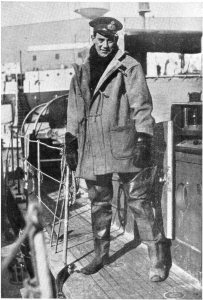Our Portrait Study: Lieutenant-Commander Arthur G. Watts, DSO, RNVR
During its early years, The Yachting Monthly presented a portrait study of some person best representing those qualities the magazine held in highest regard: a strong, upright character, leadership, seamanship, a love of sport, etc. The first portrait study was of HM King Edward, VII. During the war, when the magazine acted as the official publication for the RNVR, a number of volunteer officers were presented.
The October, 1918 issue included this study of Arthur Watts (about whom more can be found here):
During its early years, The Yachting Monthly presented a portrait study of some person best representing those qualities the magazine held in highest regard: a strong, upright character, leadership, seamanship, a love of sport, etc. The first portrait study was of HM King Edward, VII. During the war, when the magazine acted as the official publication for the RNVR, a number of volunteer officers were presented.
The October, 1918 issue included this study of Arthur Watts (about whom more can be found here):
FROM what now seems time immemorial our Magazine has held a warm corner in its pages for art and artists. They came to it in the early days, and they remain as honoured guests. Some appeared "for the first time on any stage," others turned to it in order that they might express themselves in a favourite sphere which did not interest the general public. Much of their work was produced con amore, and thus it was that the Yachting Monthly could often boast a list of contributing artists whose work was appreciated by others than those for whom the Magazine is produced. The younger of these men turned to the sea when war disturbed our peaceful lives, and all have done well in many ways. In our Honours List of last month there appeared the name of Lieut. Commander Arthur Watts, R.N.V.R., with the following official note: " This officer was in command of M.L. 239 and leader of a smoke-screen unit. He led his unit with skill and judgment in a very exposed position, and it was largely due to him that the screen was so extremely successful in his section." For this good work in the Ostend Action His Majesty was "pleased to approve the award of the Distinguished Service Order." His many friends and those who have admired his work in these and other pages will add congratulations to our own.
Those who read the "Three-Legged Cruise" which we published in August, September and October, 1913, will appreciate the fact that Lieut. Commander Watts is an unconventional cruiser, while those who know him will say that he could not well be otherwise. But probably his first taking to the sea was most unconventional of all. Wishing to buy a Great Dane, he bought a copy of the Bazaar, Exchange and Mart, in order that he might find one. Fortunately he browsed among the advertisements of things which people wished to sell, and in doing so it occurred to him that a 22-ft. half-decked sailing boat would provide more fun than any dog. Accordingly he saw and bought the said half-decked boat, and two days later sailed her from Hammersmith to Lowestoft, meeting with more adventures than are to be found in the logs of some pretentious voyages of discovery. After that the rest was easy. Later on he bought the 4-ton Mave Rhoe (in which he made the "three-legged cruise" to France, Belgium and Holland) from a brother artist and a brother contributor to our Magazine—Major Charles Pears. In Mave Rhoe he did much sailing, and he hopes to do still more when the work of the Auxiliary Patrol is less absorbing than it is, and when the "Freedom of the Seas" has been restored to the hungry men who have not sailed it for sport these four long years.
Those who read the "Three-Legged Cruise" which we published in August, September and October, 1913, will appreciate the fact that Lieut. Commander Watts is an unconventional cruiser, while those who know him will say that he could not well be otherwise. But probably his first taking to the sea was most unconventional of all. Wishing to buy a Great Dane, he bought a copy of the Bazaar, Exchange and Mart, in order that he might find one. Fortunately he browsed among the advertisements of things which people wished to sell, and in doing so it occurred to him that a 22-ft. half-decked sailing boat would provide more fun than any dog. Accordingly he saw and bought the said half-decked boat, and two days later sailed her from Hammersmith to Lowestoft, meeting with more adventures than are to be found in the logs of some pretentious voyages of discovery. After that the rest was easy. Later on he bought the 4-ton Mave Rhoe (in which he made the "three-legged cruise" to France, Belgium and Holland) from a brother artist and a brother contributor to our Magazine—Major Charles Pears. In Mave Rhoe he did much sailing, and he hopes to do still more when the work of the Auxiliary Patrol is less absorbing than it is, and when the "Freedom of the Seas" has been restored to the hungry men who have not sailed it for sport these four long years.
